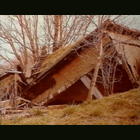
S H E L T E R
23 juni t/m 2 september 2007 Kasteel het Nijenhuis, Heino
 S H E L T E R 23 juni t/m 2 september 2007 Kasteel het Nijenhuis, Heino |
| Beeldende kunst | A_Z | |||
| SMITHSON, Robert | ||||
 | ||||
| Partially Buried Woodshed, 1970 | ||||
Een oude schuur op het universiteitsterrein, waar nog net wat hout, grind en brandhout werd opgeslagen, werd bedolven onder aarde. Op instructie van Smithson stortte een bouwbedrijf twintig vrachtwagens aarde op het gebouwtje, net zolang totdat de centrale dakbalk het begaf. Dit ‘breekpunt’ was cruciaal voor het kunstwerk, het ontmoetingspunt van zwaartekracht en actie, het punt waar de dialoog tussen interieur en exterieur begint. Vanaf dat punt moest de natuur het overnemen, zodat het verval echt een onderdeel uitmaakte van het kunstwerk. Verval, het proces van transformatie wat dingen ondergaan wanneer zij zijn overgeleverd aan de krachten van de natuur. Na enkele daden van vandalisme jegens het werk besloot de universiteit in 1984 dat het moest worden afgebroken. Vier maanden na de creatie echter kreeg het werk een nog bijzondere extra betekenis: Nadat er op de campus vier studenten waren doodgeschoten door de National Guardsmen, omdat zij demonstreerden tegen de Vietnam oorlog, spoot iemand plaats en datum van het voorval op de resten van het gebouwtje. ‘May 4 Kent 70’. Vanaf dat moment was het werk tevens een gedenkplaats, een anti oorlogsmonumente. Smithson accepteerde deze extra betekenis en maakte zelfs een ‘anti-war- poster’ met een foto van het werk + tekst erop.
by Jane Crawford and Robert Fiore 2004, 22 min, color, sound Produced for the 2004 Robert Smithson retrospective at the Museum of Contemporary Art, Los Angeles, Sheds features newly compiled footage of two of the artist's key works: Partially Buried Woodshed and Mica Spread. Partially Buried Woodshed, one of Smithson's iconic works, was executed at Kent State University in Ohio in January 1970. The piece was created by partially burying an empty shed under mounds of dirt with a backhoe until the shed's roof beam collapsed. The physical structure has long since been degraded by weather, vandalism and neglect; it has "gone back to the land," as the artist expected. However, the infamous Kent State shootings in May of 1970, in which National Guardsmen opened fire on students protesting the Vietnam War, killing four of them, has lent Smithson's entropic monument a peculiar historical resonance as a metaphorical locus of the forces and conflicts of its era. Smithson made Partially Buried Woodshed as part of a Creative Arts Festival. Other participants included Allan Kaprow, John Ashberry, Morton Subotnick, John Vacarro and the Louise Falco Dance Compagny. The site of Partially Buried Woodshed, off Summit Street on the Kent State University campus in Kent Ohio, is located near the new Liquid Crystal Materials Science building. Mica Spread was made at Rozel Point on the edge of Great Salt Lake, Utah, in April 1970, near the Spiral Jetty. A film by Jane Crawford. Producers: Robert Fiore, Jane Crawford. Editor: Amy Kalafa. Mica Spread: Original Super 8 footage filmed by Nancy Holt. Instamatic Slides: Robert Smithson and Nancy Holt. Music: Steve Reich, "Music for 18 Musicians," ECM Records GmbH, 1978. Partially Buried Woodshed: Original Super 8 footage: Mike Tarr. New Cinematography: Robert Fiore. Photographs and slides: Robert Smithson, Nancy Holt, Fred T. Smith, Alex Gildzen, Gianfranco Gorgoni. 1970 Original Super 8 film Confrontation at Kent State: Mary Leed, Jake Leed, Richard Myers, Pat Myers, Robert Ohlrica, Carla Ruff, Mel Someroski and Mike Tarr. Confrontation at Kent State and additional photographs courtesy of Kent University Libraries, Department of Special Collections and Archives. Robert Smithson audio track from an interview by Allison Sky. Additional Robert Smithson audio material from an interview made by students of Kent State University. Audio Restoration: Allen Gus, Marlin Recording, NYC. Motion Control: Joe Vecchione, Juice Media. Music: Crosby, Stills & Nash, "Ohio" from "Carry On", Atlantic Records Corporation, 1991. Special Thanks: Connie Butler; Alexandre Gunvey; James Cohen Gallery; Dr. Christine Havice, Dir. School of Art, KSU; National Gallery of Art, Washington, DC. Sheds was made for the Robert Smithson Retrospective at the Museum of Contemporary Art, Los Angeles, 2004. A Persistent Pictures Production. | ||||
 |  |  |  |  |